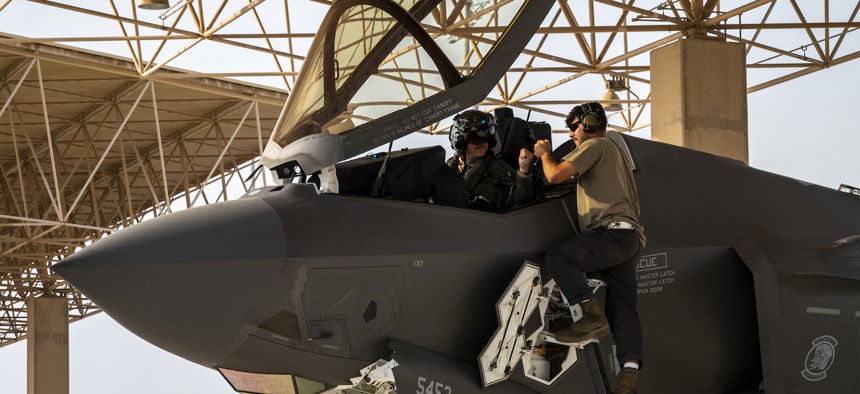
U.S. Air Force Capt. Joseph Gould, 421st Expeditionary Fighter Squadron F-35A Lightning II pilot, greets an airman from the 421st Expeditionary Maintenance Group after landing at Al Udeid Air Base, Qatar, Sept. 5, 2023. U.S. Air Force / Tech. Sgt. Leah Ferrante
Pentagon propping up F-35 readiness by buying new parts instead of waiting for repairs, GAO says
This is unsustainable, DOD concedes—and may be delaying the creation of depots that could fix the repair backlog.
Just over half of the U.S. military’s F-35s were available for missions earlier this year, thanks in part to a repair backlog that has the program office buying new parts instead of waiting for thousands of broken ones to come back from the shop, according to a new Government Accountability Office report.
This expensive course of action is helping to keep the fleet’s mission-capable rate from dipping even lower, at least temporarily, but may be hindering the construction of facilities needed to get the repair pipeline up to speed, the report said.
As of March 2023, the U.S. Lightning II fleet had a mission-capable rate of 55 percent, far below the program’s goal of 85 to 90 percent, GAO said. That’s down roughly 10 percentage points from 2021 and is about the same as in 2022, according to a February report from the Congressional Budget Office. The mission-capable rate is the percentage of time during which the aircraft can fly and perform at least one of its tasked missions.
The low rate is due in part to delays in standing up facilities for depot repair and a growing backlog of parts that need to get repaired, the report said.
As of March, more than 10,000 F-35 parts were awaiting repair, so the program office had begun buying new parts instead.
“According to DOD officials, this is a practice that program officials do not believe is a sustainable solution. According to those same officials, this method keeps aircraft flying,” GAO said.
The unanticipated spending on new parts could “further reduce the amount of money that DOD could use to stand up military service depot repair capacity,” the report said.
Released on Thursday and entitled “F-35 Aircraft: DOD and the Military Services Need to Reassess the Future Sustainment Strategy,” the report arrives days after a Marine Corps F-35B crashed in South Carolina, flying onward some 60 miles after its pilot was forced to eject.
If the Pentagon doesn’t fix these repair delays, GAO said, readiness rates will continue to decline.
“We must grow our sustainment capacity and efficiency around the world. To do so, we must stand up our global repair, transportation, and warehousing network at a faster pace, incentivize industry behavior toward desired availability and affordability outcomes, and remain laser focused on increasing all aspects of mission capable rates for fielded aircraft,” F-35 Program Executive Officer Lt. Gen. Mike Schmidt said in a statement.
The report also said the Pentagon’s “heavy reliance” on contractors to manage F-35 sustainment leaves the government with “limited decision-making ability and influence over depot maintenance.”
The Defense Department wants more control over sustainment but doesn’t have a clear pathway to getting there, GAO said.
The Pentagon is currently considering a performance-based logistics contract with Lockheed Martin, under which the company would be paid to produce outcomes, not provide quantities of parts and services. However, the Pentagon is still unsure if it wants to move ahead with this choice as it would lose flexibility locked into this five-year deal.
Defense officials told GAO there was a “disagreement” within the department over whether it was ready to enter a PBL contract.
“For the F-35 program, and its continually expanding fleet, the process to put such a contract in place is complex, and we will take the time necessary to get it right. If we are unable to do so, we will move forward with another way to meet warfighter sustainment requirements. In the meantime, we continue to provide support through our existing contracts,” F-35 JPO spokesperson Russ Goemaere previously told Defense One.
The GAO report notes that the Pentagon is gearing up for yet another big change: moving responsibility for F-35 sustainment from the JPO to the military services by 2027, as required by the 2022 National Defense Authorization Act.
“However, as of February 2023, DOD had not finalized the specific roles and responsibilities of the military services, Joint Program Office, and prime contractors. The decisions the military services make about how they will sustain the F-35 will have significant implications for the entire F-35 program, including international partners,” GAO said.
Over its lifetime, the F-35 program is expected to cost taxpayers $1.7 trillion, $1.3 trillion of which will go to decades of operating and sustaining the aircraft, GAO said.


